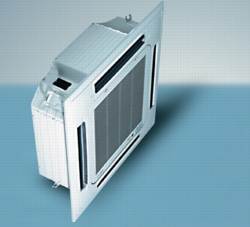Vaillant enters VRF air-conditioning market

The range of indoor units available with Vaillant’s DVC VRF air-conditioning system includes cassettes, wall-mounted and ducted.
Following its entry into the UK air-conditioning market last year, Vaillant has enlarged its product offering with the launch of a VRF range. Designed for smaller installations, there are two sizes of condensing unit (15 and 30 kW) using R410A. They can be combined with up to eight and 16 indoor units, respectively. The range of indoor units includes wall-mounted, cassette and ducted types, which can be mixed and matched as required. A single controller can operate up to 64 indoor units, as well as multiple outdoor units. The initial launch offers 2-pipe units, but 3-pipe and modular configurations are being developed for introduction in the near future. Called DVC, the range incorporates Copeland’s digital scroll compressor technology, which is said to offer an elegant solution to variable capacity by mechanically unloading the compressor by separating the fixed and orbital scrolls. A solenoid valve unloads the compressor by converting the cooling demand into an operational time signal to deliver capacity control down to 10% of full load without the need for refrigerant bypass circuits used by many inverter systems. Vaillant’s comprehensive warranty is standard on the DVC range. If a system fails for a reason not related to installation, Vaillant will send a service engineer to make repairs on behalf of the contractor.
Related links:


